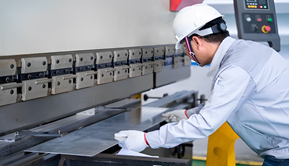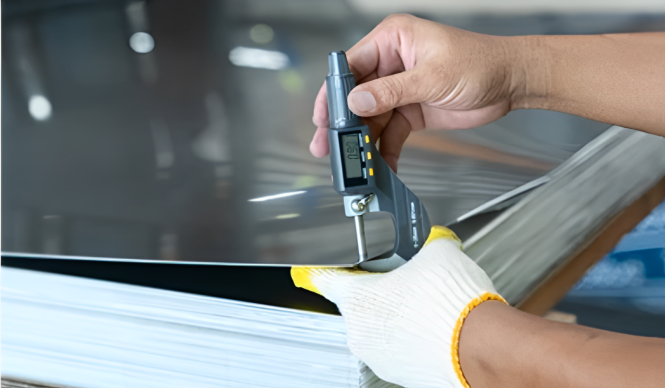Does Silver Rust? – An Ultimate Guide
Many people wonder, “Does silver rust?” due to its similarities with metals that do rust, such as iron. Silver is not a new metal in the race but is widely accepted around the globe by multiple industries. Ignoring the question may lead you to face material loses, useless formations, and loss in revenue. Therefore this guide will clarify the answer on if
silver does rust or not. You will also unveil insights on expert tips on preventing Silver, cleaning process and better storage tactics so your silver stays in pristine condition. Let’s uncover the facts!

What is Rust?
Rust is the oxidation of iron produced by the reaction with water and oxygen. When moisture in the air or water touches iron surfaces, this is the process, called oxidation. The chemical reaction can be simplified as follows: F (iron) + O₂ (oxygen) → n₂Fₓ (iron oxide). The rust is mainly on ferrous materials because they contain iron which readily oxidizes in the presence of moisture. Other metals, such as aluminum and stainless steel, create protective oxides that prevent rusting.

Revealing Facts On Does Silver Rust
Composition of Silver
Ag is a group 11 element on the periodic table. This is a lusterous metal transition element that is also very conductive.
| Sr. No. |
Property |
Value |
| 1 |
Atomic Number |
47 |
| 2 |
Chemical Symbol |
Ag |
| 3 |
Atomic Weight |
107.8682 |
| 4 |
Group |
11 |
| 5 |
Period |
5 |
| 6 |
Block |
d |
There are two main forms of Silver including pure silver as well as sterling silver. Uncover more details about the two down in the table below:
| Sr. No. |
Feature |
Silver |
Sterling Silver |
| 1 |
Purity |
99.9% pure |
92.5% pure silver, 7.5% other metals (usually copper) |
| 2 |
Durability |
Soft and malleable |
Harder and more durable due to the alloy |
| 3 |
Tarnish |
Less prone to tarnish |
More prone to tarnish due to the copper content |
| 4 |
Common Use |
Primarily for coins, bullion, and industrial applications |
Jewelry, tableware, and other decorative items |
| 5 |
Hallmark |
May have a 999 or FS hallmark |
Typically has a 925 or STER hallmark |
| 6 |
Cost |
Generally more expensive than sterling silver due to higher purity |
Less expensive than silver due to lower purity and added durability |
| 7 |
Feature |
Silver |
Sterling Silver |
What Contribute to Rust?
Actually rust results from a reaction of water, iron, alongwith oxygen. This is only how it works for iron containing metals. However, Silver does not rust. Since it has no iron, you won’t see the silver degrade through a process of rusted formation.
Tarnishing: Silver is a Form of Corrosion
Although silver does not rust, it does ‘tarnish’. Ag₂S is responsible for tarnishing the silver. If you happened to get a dull, grayish coating on your silver items overtime, it is made of aluminum sulfate. You shouldn’t confuse rust with tarnish. The rust is iron oxide, the tarnish is silver sulfide. The appearance of your silver tarnishes, but it doesn’t compromise its integrity.
Factors that Cause Tarnishing in Silver
Tarnishing is the process, in which silver gets in contact with some of the elements present in the surrounding conditions. Knowing these reasons will assist you in preventing the loss of your silver products.
Exposure to Sulfur Compounds
Silver tarnishes because it reacts with some element found in the air such as sulfur and create black compound called silver sulfide. One way of preventing contamination is by keeping silver in airtight containers.
Humidity
It is also important not to subject the surface to high levels of moisture since this causes faster tarnishing. Rinse aid causes moisture and thus makes it possible for the silver to react with other chemicals in the air. You should keep your silver away from humidity to extend the rate at which it will be affected.

Air Pollution
When one is living in an urban area, then there are high chances that tarnishing will happen more frequently due to bad emissions such as sulfur dioxide from industries. Outdoor pollutants are the main cause of turning silver dull; therefore, limiting time spent outside is beneficial when your silver is involved.
Contact with Chlorine
Chlorine is used in cleaning compounds and swimming pools, for example. In the presence of chlorine, the silver discolours more rapidly, meaning that the members who live in an environment where they use chlorine either in the swimming pool or in the house will tarnish the silver faster than the others.
Beauty Products
Some elements used in perfumes, lotions, and cosmetics are known to cause tarnishing. This is especially important when you are wearing silver Jewelries, it’s better not to apply those products.
Skin Oils and Sweat
Some natural oils and acids on human skin can react with silver. This contact, however, as stated earlier contributes to tarnishing over time.
Preventing and Reducing Silver Tarnish
Here are some of the most effective tips on how to maintain your silver to have that shiny appearance all the time.
Storage Techniques
Vacuum Containers: Make use of seal containers for storage. This reduces air circulation and attacks by humidity which results in tarnishing.
Anti-Tarnish Strips and Cloths: Apply anti-tarnish solutions that effectively require moisture and sulfur to be present in order to function. These are also used to protect your silver during storage.
Cleaning and Maintenance
Light Clean Up: Polish up silver utilising zero abrasion gloves specifically made for silver items. This will ensure that it remains shinny without damaging the surface of the metal.
Avoid Harsh Chemicals: Try to stay away from abrasive or very acidic cleaning products. They can cause damage to your silver and speed up tarnishing.

Protective Coatings
Lacquers and Coatings: Apply protective lacquers or coatings. They impede silver from reacting with air.
Limitations of Coatings: And remember that coatings can wear off over time. To maintain protection, you’ll have to reapply them.
Proper Use and Handling
Remove Before Activities: Remove silver jewelry before swimming or using water or chemicals.
Avoid Exposure to Beauty Products: Wear silver only after applying cosmetics and perfumes. This minimizes the contact with the tarnishing agents.
How to Clean Tarnished Silver
Gather Materials
Before you begin, gather the following materials:
- Soft cloth or microfiber towel
- Mild dish soap
- Baking soda
- Aluminum foil
- Non-metallic bowl
- Boiling water
Having everything ready will help you clean efficiently without missing any steps.

Soap and Water Method (For Light Tarnish)
The method works really well if items need light cleaning.
Step 1:
Use combination of light soap along with some hot water within a plastic container. Avoid heating the water so highly as it could harm delicate silver.
Step 2:
Put a softcloth or microfiber towel in the soapy water. Use the cloth and scrub gently over the tarnished areas of the silver. Do not use heavy pressure as it will scratch the surface.
Step 3:
Rinse the silver in clean, lukewarm water, thoroughly. It’s this that helps ensure no soap residue presents which can dull the shine.
Step 4:
The item should be immediately dried with a soft cloth. Water spots and further tarnishing are prevented by drying right away. Silver is buffed to shine.
This is a good way to clean or polish your silver quickly and keep the luster nice.
Baking Soda and Aluminum Foil Method (For Heavy Tarnish)
To get rid of silver that is extensively tarnished, you need a more aggressive cleaning method. The chemical interaction between aluminum foil and baking soda produce an effective tarnish remover.
Step 1:
First you need to place the Aluminum foil within plastic bowl. The foil is essential to the process.
Step 2:
Drape the tarnished silver items directly on the foil. Make sure for the reaction to happen the foil has to be touched by them.
Step 3:
Next begin sprinkling silver with baking soda. In general for a cup of water, utilize a tablespoon of baking soda.
Step 4:
Submerge the silver into the boiling water in the bowl until it is completely covered. Aluminum foil and baking soda will react with the hot water.
Step 5:
Let the chemical reaction takes place, the tarnish will start to come off. For heavier tarnish, the longer you let it sit.
Step 6:
To avoid burns, gently remove the silver items using tongs or a spoon. The water will be boiling, and the items will be hot from the boiling water.
Step 7:
Under clean water, rinse the silver thoroughly to remove any remaining residue.
Step 8:
Immediately dry the silver with a soft cloth. Buff the silver gently to restore its original luster.
This is a very effective way to get heavily tarnished silver items back to their original beauty.
Polishing with Silver Cloth
Once you have chosen one of the above ways and polished, you can then ease the shine by using a specially made silver polishing cloth.
Step 1:
Rub the tarnished areas gently using the silver polishing cloth. These chemicals are specifically invented to clean and shine silver in the cloth.
Step 2:
Make small, circular motions on the cloth. Areas that have tarnish or dullness, but not too much pressure, as too much pressure may scratch.
Step 3:
Polish until the silver is nice and shiny. It will remove any remaining tarnish and make the silver shine.
Rinse and Dry Thoroughly
When cleaning process finished, you need to rinse the silver and dry it to remove any left out residue.
Step 1:
Under clean, lukewarm water, rinse the silver. Don’t leave any cleaning products on the surface as this will eventually dull the finish.
Step 2:
Immediately dry the silver with a soft, lint-free cloth. Gently buff it to further enhance its natural shine. Leaving the silver wet can result in water spots or the formation of new tarnish.
Store Properly to Prevent Future Tarnish
It is important to keep your silver looking its best; the correct storage is essential.
- Avoid storing your cleaned silver in air and moisture by putting it in an airtight container. This will prevent the tarnishing from happening as fast.
- Anti-tarnish bags or cloths can also be used to protect silver from tarnish.
- Do not keep your silver in direct contact with wood or rubber as they are known to promote tarnishing.
The Role of Silver in Modern Applications and Corrosion Resistance
Silver is important in many industries due to its good electrical conductivity and corrosion resistance. Electronics and medical equipment will have silver and you’ll definitely find silver in them. Learn about silver’s diverse applications and its ability to resist corrosion.
Electronics and Circuitry
Silver is essential to electron flow in electronics. Its high conductivity makes it ideal for electrical contact, switches, and PCBs. Silver corrodes slowly and therefore resists it, keeping circuits operational in harsh environments where other metals might fail.
Solar Panels
Solar technology depends on the use of silver. Its ability to resist corrosion helps photovoltaic cells resist degradation, such as that caused by sunlight and environmental conditions, and allows the panels to retain their efficiency. By making them less likely to require repairs in the first place, they become more reliable and durable.

Medical Equipment
Antimicrobial properties of silver, and its corrosion resistance, are important for medical tools. Silver’s ability to reduce infection risk and keep surgical instrument and wound dressings intact over time makes it desirable in these products.
Water Purification Systems
Silver coated filters are used in water purification to clean the water while preventing corrosion. Silver inhibits bacteria growth, and since it doesn’t degrade when exposed to water, you can be sure that these filters will last long.
Jewelry and Decorative Items
Silver is an everyday favorite for jewelry and décor. Silver tarnishes but does not corrode. If you take proper care of your silver items, you can continue to use them years after buying them. Silver’s durability means it’ll continue to be a popular choice for long-lasting designs.
Conclusion
Silver doesn’t rust. Your silver is not affected by rust as only iron based metals are affected by rust. Of all of the metals, silver is most sensitive to tarnish, but it is easy to take care of and doesn’t weaken the metal. Silver lasts longer if it’s cared for properly. Store them correctly, clean them regularly and handle them with care so they stay shiny and beautiful. Silver is a very durable and valuable metal. With proper care, it will be able to remain strong and will stand the test of time.
FAQs
Does Real Silver Rust?
Real silver does not rust because it does not contain iron. Iron (to oxidize) forms rust.
How does 925 Sterling Silver Rust?
Sterling silver doesn’t rust. Rust doesn’t happen because it doesn’t contain iron. 925 sterling silver is known to tarnish over time.
Can 925 Sterling Silver Rust in Water?
No, rather it tarnishes. After contact to water, it should be dried off well to reduce tarnishing.
Does Water Rust Sterling Silver?
In water sterling silver, like 925 silver, doesn’t rust. Tarnishing is avoided with regular exposure to water, however. Keep water off of the unit and wash regularly.
Does Silver Rust in Water?
Rust doesn’t come from silver, unlike iron specific process. Silver can tarnish; conversely, though, it does not oxidize. Silver should not tarnish, even in saltwater or chlorinated water, however.
Can you Tell me how long Silver takes to rust?
Silver doesn’t rust. Instead, it is tarnished with time. It can tarnish quickly on in humid environments or years, depending on conditions.
How Long Does it Take for Sterling Silver Rust?
Sterling silver doesn’t rust. Usually tarnishing begins months after, but fast depending on what it is exposed to, air, moisture, chemicals.
Silver can lose how many electrons in rusting process?
Iron doesn’t rust, so for silver doesn’t lose electrons, like iron does, during rusting. Instead it tarnishes by forming silver sulfide on its surface.
Does Fake Silver Rust?
Indeed, fake silver with iron does rust over time. Rusting happens if the item has a silver coating on top of the metal base, and its silver coating starts wearing off.









